|
Tonight was a particularly exciting night. Around 4am the bridge called us down in the science lab, the phone was practically dripping with excitement. We found an alien face in our data. Now, if you can't see the alien below it just means you haven't been staring at multibeam data for long enough. But it's there! I guess sooner or later we were going to find a feature we could interpret creatively. So all up it was a very exciting night. We've been finding a lot more going on on the sea floor than any of us had imagined. Although it is unlikely that we're in the process of waking up an alien, it is a particularly exciting example of some of the features that we have been finding out in the wild blue yonder here.
0 Comments
Life here on the ship has been all go of late. On "hump day", halfway through the cruise, we swapped shifts. This has seen me bumped to the midnight to 8am shift. Which has been lovely, from a quiet peaceful ship perspective, not so lovely from a sleep perspective. But it is a very interesting experience, and always good to gain some extra respect for people who regularly work nights. It is not an easy thing, but it is all part of the adventure. But for the time being we are still all at sea. The weather has been fantastic, the sky a perfect surreal blue and the sea has been beautiful and calm. Nothing exciting like a storm to report, just the occasional bolt of lightening over the horizon at night. All up it has been the perfect conditions for mapping, the ship has been still enough to get great quality data going quite quickly. Which is fantastic because we are starting to run short on time. Aside from providing a fantastic environment for mapping this part of the Pacific is also excellent for brilliant sunsets (and as it turns out sunrises, viewed through CCTV at 5am).
Long term followers of this blog will be aware of CTD's and their purpose within oceanography and mapping. But for those of you who have not had the pleasure yet the image below is of a CTD (Conductivity, Temperature and Depth Sensor) with a carousel of niskin bottles. There are multiple purposes for a CTD cast. The CTD can collect high quality data regarding the Salinity (closely related to conductivity), Temperature and Pressure (depth). In this case the CTD was also measuring oxygen and chlorophyll. The bottles are used on the way up, each bottle is "fired" at different depths to collect a water sample which can then be analysed on the surface. There is more information here written by the official science communicator on board. In this case many of the crew were being trained on the use of a CTD and how to operate the crane and A-frame appropriately so we had a number of opportunities to practice and get some great photos. It was also interesting from the point of view of an observer to see how different life on board is for the crew of a research vessel than say a cargo or cruise ship. There are a whole range of new skills to learn, from just working with scientists, to dealing with some sensitive and occasionally finicky pieces of equipment. All up our cast went really well, we got data that looks appropriate for the region and that information can be used to calibrate our soundings. And just in-case you were starting to think it's all about hard work there is the occasional moment of light hearted activity. #ScienceSelfie, once all the science is over and done with!
So now we are navigating by gut instinct and our general feel for what canyons should do. We're following the canyon walls around to see what we can find, it's exciting, relies on us being completely on the ball, and is really feeling like an adventure.
As you can see from the line below. We had a grand plan of following the canyon up and down with neat strokes to find out what it's doing. Sadly, the bit that shows up green is not canyon and is distinctly not of interest. It is for this reason that we have ventured off track and are investigating what there is to see off to the side (easily visible in details below). One of my favourite places to visit on the ship is the Bridge. Happily this ship is crewed by a very friendly set of watch keepers who are more than happy to have me visit and take photos and wander around asking about every instrument they have visible. What is the point of being a scientist if you don't ask questions all the time? The downside to visiting the bridge is passing this particularly unfriendly red sign. Which I find to be off-putting in pretty much every circumstance, although I have been granted authorised entry. If you count authorised entry as "Of course you're welcome, would you like tea?". The view is pretty awesome, when the weather is good. And there's always someone doing something in an incredibly relaxed manner. At some point in my life I was given the advice "don't worry till you see the crew worrying, then you can worry", so if you're concerned about high seas, bad weather or beeping red lights it's the place to go for reassurance. It's also the place where everything comes together. The science (where the ship can actually scan), the navigation, the organisation, it happens out of this room.
As you may or may not know the science we're doing out here on the Ontong Java Plateau is the science of Oceanography, in this case the subset of that which is mapping the sea floor. Now in the golden olden days of oceanography this would have involved a pile of people up on deck with a long rope and a rock tied to the end. Rock is then lowered into the water, regular marks on the rope let you know how deep it is when the rock hits the bottom, the rock is retrieved and the process is repeated over and over and over again. The downside of this process is that it's incredibly labour and time intensive and gets relatively few results over time. However the notable upside is that there would be something to photograph. There would be action, drama and excitement. It's also a process that's really easy to understand. It's easy to communicate and it's easy to trust, because it works. No such luck these days. Whilst the science has improved greatly the ease of communication has diminished significantly. This is what you get these days. Banks of computer monitors spitting out piles of numbers and trying to render them in a way that means something to the human brain. It's incredibly detailed, we can get great data going at 10 knots (I know this to be a speed faster than 8 knots but slower than 12 knots, couldn't give you more than that). We can get data while we sleep, eat and write blogs. And it's great. But it really isn't anything too exciting to behold in a blog. The most exciting piece of drama I could provide is the occasional red flashing box. Which is a shame. Because it is genuinely exciting! We're getting data out that looks a bit like this. The bottom box shows a cross-section of the sea floor. That's a bit of the sea floor that no-one has ever seen before! It's likely that no one else will come out here for a good while too. This is as close to genuine exploration of the world that it really gets to these days, and it's pretty thrilling to be part of it, even if just for a few weeks. So for all there is no photogenic excitement for you, there is some very awesome and beautiful data. Schmidt being the awesome Schmidt in a few months you'll also be able to download this data and have a play around too. Sniff around the sea floor and see what you can see! Sure you won't be the first person to see it, but you'll be up there on the list. For anyone wanting a break from their computing and data crunching there's always the CCTV. A nice little window out into the real workings of the ship with it's little dramas and secrets. Not to mention the beautiful little waves lapping the boat.
And so we're on our way to the Science Site, as it's being referred to. It's going to take about 2 days of steaming to get there. For the landlubbers amongst you that means that we're just sailing at about 12 knots, no stopping for science, no stopping for a quick swim or to get some milk from the shops. We're just heading almost due south for the time being. The cool thing about this ship is that we can scan the sea floor as we go. So even at the speeds we're going we can get some pretty cool data about what's going on down below. As it turns out there's zip going on down below. It's flat, and flat and more flat. But just because we're not officially at the science site yet doesn't mean it's all milk and cookies and swapping salty sea shanties. Ship life is a 24 hour venture, there's always work to be done, people sleeping and people looking for something to do. Because Schmidt Ocean Institute is awesome and understands the value of Science Communication they've sent a full time blogger and scicomm fellow on board (no not me, I wish!). That's the kind of work that happens all day every day too. Here we have a very important photo in progress, the Captain taking a photo of our Chief Scientist looking all sciency in the control room. To be fair we were actually doing science at the time, and no one put on a lab coat which is always a relief, remember, science DOES NOT = lab coat. There was plenty of collaboration regarding this particular photo, which is actually great to see. It shows that the crew is not only supportive of the science but also supportive of the communication aspect too. And that support is always going to improve a voyage. And that is it for the time being. We've been going well, no technical issues, all the science minions have been learning the new systems incredibly fast and we're now just excited to get to the canyon and see what we're going to see in the deep blue sea.
Having travelled 34 hours to get to Phonpei I was pretty happy to be on land, happy bordering on ecstatic. The flight was fascinating and beautiful and a stark and sudden reminder of how huge the Pacific is. I've flown over the Pacific four times before, but never really had anything to provide me with scale. It's only with scale that we can begin to understand how freaking big something is. In the case of the Pacific, it's huge. With these tiny islands holding on just above the sea surface dynamic with all the complexities of life. Seeing the ocean like this, our mission has become even more intimidating. Setting out into relatively uncharted waters, to see what's there, to make the maps. It's exciting undoubtedly, but it's also scary when you consider how small one ship is when faced with the whole of the Pacific. We're going to be out there bobbing in a tiny tin can. Not that I can really complain, we'll have internet and fresh water on tap, a much cushier journey than the original settlers had. On the island we did the usual island things. We had dinner by the bay, saw a majestic waterfall and some groovy ruins and ate some very. It was a lovely few days off before work began.
So over the last few days we've been in dock on the Falkor getting set up and trained and generally prepared for life at sea. It's always exciting getting introduced to a new ship, and the Falkor is a treat for the hard working scientist. We've been introduced to the ship, introduced to the mess and the coffee machine and introduced to our new home the dry lab, where we will be processing data. It's all looking good so far, we've got a cruise plan which will no doubt change. We've got a scientific mystery to solve and just over 2 weeks to solve it in, with a whole ship and crew at our disposal. I've been amazed at how keen the crew are to help us out and how curious they are about the science that we're doing. Anything that adds enthusiasm to the task at hand is fantastic, and undoubtedly in the long run their curiosity will improve our results. And probably our dedication to the task when fatigue starts to kick in. We've done the standard safety and protocol inductions, don't slam doors, don't stand in fire doors (my parents trained me well) and don't be a complete fool. We also did a fire drill, which involves preparing to evacuate. It would have been quite a bit more fun had it not been raining with monsoonal enthusiasm on us. But I was pretty impressed with how well we did, putting on life-jackets and high-tailing it to the required locations. It was a bit of a shame that we didn't get to do the whole evacuation, inflatable slides and all, but perhaps some things are better left to the imagination. We've got a lot of training to do over the next few days, on quite a few new systems with new kinds of data. Which is exciting and a very fun kind of challenge.
The Scientific crew is a random bunch we've got two Aussies, one Brit, one Israeli (representing New Hampshire) and a fella from Guam. None of us know each other and only one of us has used these kind of data before. So there's going to be a bit of a social experiment on board as well. The captain is particularly interested to see how it all turns out because we don't have any preconceived ideas of what people can and can't do. All up it's pretty exciting! The real ocean starts tomorrow. And we're off! The bright blue ocean with all its charms and threats is calling. There were a number of little challenges to overcome before departure, from refuelling (bunkering) to fixing the occasional sensor, but amazingly they all got done in time. It was quite exciting for us not to get held back by island time (it's a real thing, believe me). We had a pilot on-board to guide us through the gap in the reef, which was a pretty narrow gap. So we were very glad to see the reef pass us by. There is a ship a few kilometres further up that was trapped on the reef, a good reminder of the importance of careful seamanship. In a very Pirates of the Caribbean kind of way. All up I'm pretty excited to be off and away. There's a lovely smooth roll to the ship and we're incredibly well set up for the science that we're going to be doing (more on that later). Whilst we can't start mapping yet, because we're still in Micronesian waters and don't have permission to map there, it's still pretty exciting to start seeing how it's all going to be working together.
I'm on the 8am-4pm shift, which is about as cushy as life gets on a ship, and I'm looking forward to seeing some new and exciting underwater features that no one's ever seen before! The photos below are of the harbour and, most importantly, the mess! With some very very good food. We have another day of steaming ahead of us and then we'll arrive at the Ontong Java Plateau, our area of study, at about 4am the next day. So we've got a good few days to get settled in, find our way around and get washing done! Then it's onto the science. |
Amy T
Interested in nigh on everything from science and marketing to communication and food, with lots of stuff in between. Gradually working on increasing sustainability through GIS, systems thinking, positive communication and community. Categories
All
|


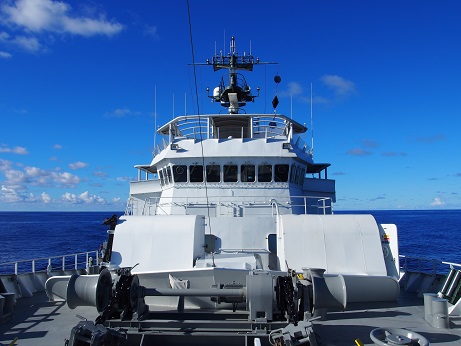






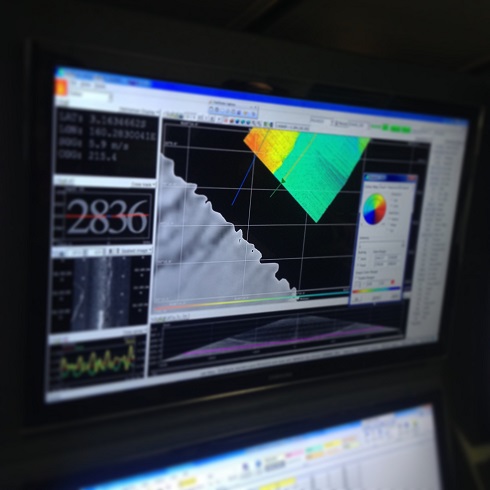














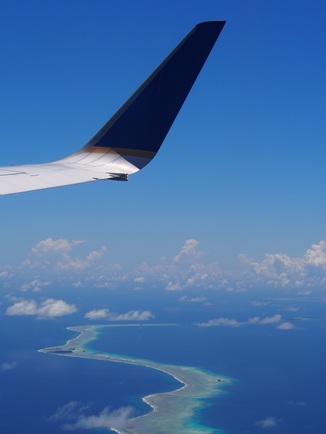









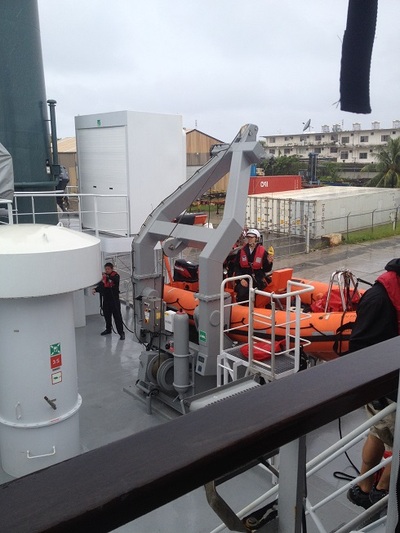

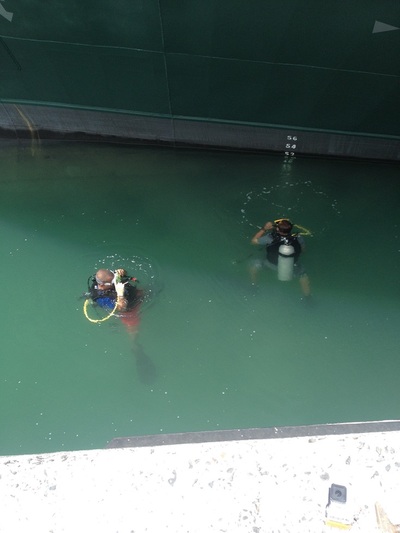



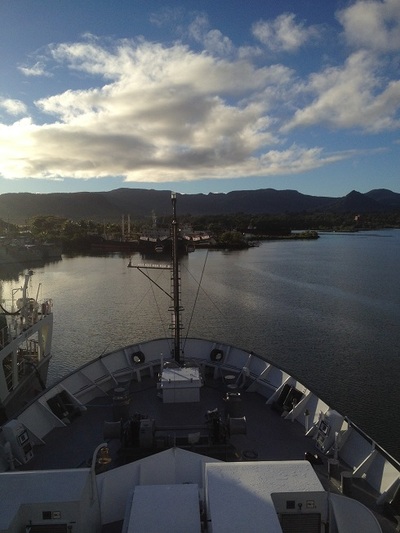



 RSS Feed
RSS Feed
